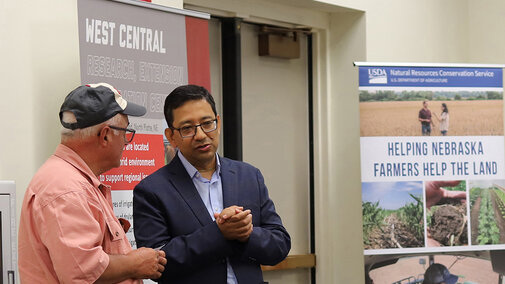Agriculturists, from growers to livestock producers, rely heavily on the soil and its health to make their operations thrive. In a collaborative effort, the U.S. Department of Agriculture (USDA) Natural Resources Conservation Services (NRCS) is supporting Nebraska Extension, specifically Bijesh Maharjan, soil nutrient and management specialist’s Soil Health Gap project and Soil Health School outreach.
“We are creating an interactive map for the state (Nebraska), where any grower can put in coordinates of cropland, and the map will show them where they belong in terms of agroecological zone,” Maharjan said.
The map will be based on benchmarks Maharjan and his team created by gathering data from native lands with no cultivation. So, producers will be able to compare their land with native land. In managed land, the sod has been cultivated, losing topsoil and carbon over time, resulting in a lower health score than undisturbed land.
“In obtaining baselines, the idea is to know where the ceiling is and how far can we go,” he said. “And looking at native land and other variables like climate and time.”
In Scotts Bluff County, they found native land with 4% organic matter, which is a staggering amount, as most decent cropland has 2% organic matter.
Native land has a natural equilibrium. By giving farmers benchmark data, they can determine the gap in soil health in their lands compared to native land and plan practices to manage and reduce that soil health gap. The project aims to cover two extensive land mass areas, one each in the state's east and west, with support from NRCS. Maharjan and his group use the NRCS land classification system, Major Land Resource Area (MLRA), to identify the native land and get data for the map. Over time, the entire state will have reference data a grower can use.
Another aspect of the program has been the Nebraska Soil Health School.
“We have organically stepped into the outreach portion of soil health activities with growers, feedlots, and other agriculture outfits,” Maharjan said.
The Soil Health School will hit western Nebraska this year with classes addressing healthy soils from different angles, like dryland, irrigated, rangeland, integration and economics. This year, classes will be held in Crawford, Sidney and North Platte.
In February, USDA NRCS and the University of Nebraska had a joint meeting to foster and expand collaboration, and out of many collaborators working on projects, NRCS invited Maharjan to present on his soil health efforts.
Assisting Maharjan with the Soil Health Gap project is Saurav Das, research assistant professor in soil health and biogeochemistry, and Nicole Heldt, the Soil Health School research project coordinator.

